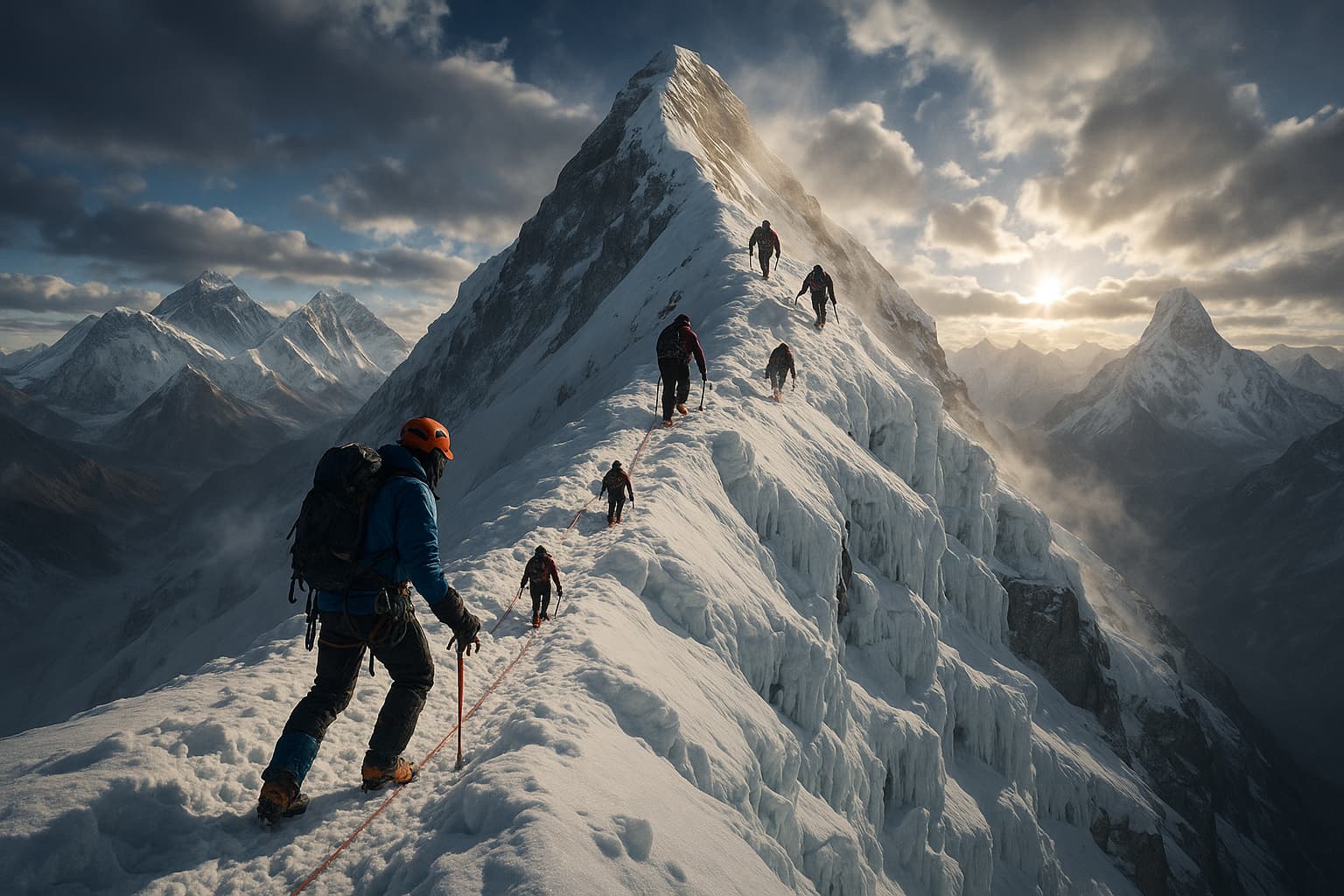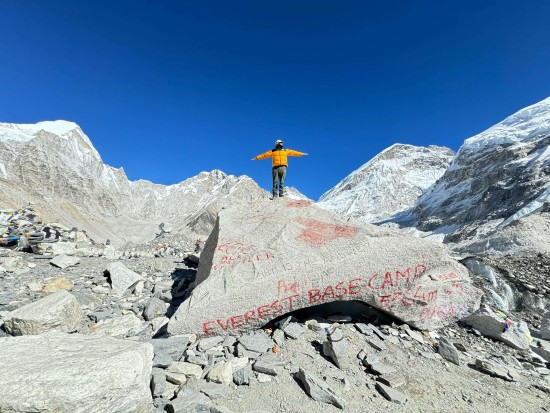Lobuche East Climbing

7% OFF


From USD 2799
Durations 16 Days
We Offer GROUP DISCOUNT In This Trip
100% Response Rate
Lobuche East Climbing Overview
For novice climbers and trekkers alike, the Himalayas offer different experiences. Lobuche East Peak, standing at 6119 meters, is located along the Spice Trekking route, which is extremely popular among tourists. The mountain also offers moderately difficult climbs, which, though challenging, allow for stunning views of Everest, Lhotse, Nuptse, and Ama Dablam while achieving a vertical gain of awe over the majestic scenes in the world. Riding the flight to Lukla is a perk; however, after Namche Bazaar, Dingboche, and Tengboche come climbing, which are pristine customs of the Sherpas, richly served as a perspective on high-altitude civilization rich with precocious mountains.
With all the listed benefits, there are still some appealing drawbacks to Lobuche East Peak Climbing. Some include the weather, the unpredictable, practically precluding near for mountain crampons, ropes, and axes. Of course, these add additional mentally taxing, strenuous high altitude levels that require sweltering range hiking, though facts tautologically point out successful ones are few and far between. During the shift from base to high camp, tents become the main form of shelter, while in Sherpa towns, people friendly throng the teahouses that serve as lodge range menus. In terms of Nepalese logistics, or need supplies permits, domestic trailers, seasoned guides, gear rent, and porters.
What is Lobuche East Climbing
Lobuche East is one of the best trekking peak climbing expeditions in the Khumbu region of Nepal, located near the Everest Base Camp trekking path. Lobuche East (or Lobuje East) is one of Nepal's popular peaks, rated as a ‘trekking peak’ by the Nepal Mountaineering Association (NMA) due to its 6,119 meters (20,075 feet) height. It is ideal for climbers aiming to have an experience of Himalayan mountaineering without diving into the deep waters of extremely technical or 8000-meter peaks. The climb also serves astonishing oceanic views of Everest, Lhotse, Nuptse, Ama Dablam, and Pumori, making it one of the most beautiful climbs in the area.
 Lobuche East is thought to be of medium difficulty (grade PD+), but does require a good physical fitness as well as some basic mountaineering skills like climbing equipment (Crampon, Harness, Mountaineering Ropes, Ice Axe, etc). The expedition starts with the flight to Lukla. After that, it is a multi-day trek to famous Sherpa villages like Namche Bazaar, Tengboche, Dingboche, and others for the best acclimatization. An early rise pre-summit is forced, thus making the journey involve a high camp at ~5400 meters pre-dawn regions. Those longing for a little more than trekking will find their ideal in the Everest region, offering a real alpine climbing experience in the heart of the Himalayas.
Lobuche East is thought to be of medium difficulty (grade PD+), but does require a good physical fitness as well as some basic mountaineering skills like climbing equipment (Crampon, Harness, Mountaineering Ropes, Ice Axe, etc). The expedition starts with the flight to Lukla. After that, it is a multi-day trek to famous Sherpa villages like Namche Bazaar, Tengboche, Dingboche, and others for the best acclimatization. An early rise pre-summit is forced, thus making the journey involve a high camp at ~5400 meters pre-dawn regions. Those longing for a little more than trekking will find their ideal in the Everest region, offering a real alpine climbing experience in the heart of the Himalayas.
Key points about Lobuche East Climbing
- Lobuche East rises to 6,119 meters (20,075 feet) as a trekking peak in Nepal.
- You'll find it in the Khumbu area close to the Everest Base Camp trail.
- The ascent has a PD+ (tough) rating fitting for strong hikers with basic mountain climbing know-how.
- From the top, you can see jaw-dropping views of Mount Everest, Lhotse, Nuptse, Ama Dablam, and other Himalayan giants.
- This trip mixes high-altitude hiking with real mountain climbing, making it perfect for thrill-seekers.
- The journey starts with a pretty flight to Lukla, then a hike through Namche Bazaar, Tengboche, Dingboche, and Lobuche.
- Climbers often stop at Everest Base Camp or Kala Patthar to get used to the thin air before heading to Lobuche East Base Camp.
- During the trek, you'll sleep in teahouses, while at the base and high camps, you'll stay in tents.
- To climb, you need a special permit from the Nepal Mountaineering Association (NMA).
- The majority of people climbing Everest hire guides and porters with proper certification. This helps keep them safe and takes care of the trip details.
- You need key climbing equipment like crampons, ice axes, ropes, and harnesses to climb. You can rent these items in Kathmandu or Namche Bazaar.
Lobuche East Climbing Highlight
- From the top of Lobuche East, you can see breathtaking views of Everest, Lhotse, Nuptse, Ama Dablam, and other famous Himalayan mountains.
- This peak suits trekkers who want to try Himalayan climbing with some technical challenges, but nothing too extreme.
- The climb mixes the classic Everest Base Camp trek with an exciting mountain ascent.
- As they go up, climbers can learn about Sherpa culture and check out old monasteries and traditional mountain villages.
- The climb is somewhat hard, so it's good for fit people who know a bit about mountain climbing.
- Lobuche East isn't as busy as other popular trekking peaks like Island Peak or Mera Peak, so you can enjoy a quieter trip.
- Going above 6,000 meters gives climbers a tough high-altitude challenge that can boost their confidence for bigger climbs later on.
Best time to do Lobuche East Climbing
You'll find the best conditions to climb Lobuche East Peak in spring (March to May) and autumn (late September to November). These seasons give you stable weather, clear skies, and comfortable temperatures, making them perfect for trekking and climbing. Spring brings out blooming rhododendrons and warmer days, while autumn offers crisp air and stunning views of the Himalayan peaks. It's smart to avoid the monsoon season (June to August) because heavy rains can make trails slippery and increase avalanche risks. Winter (December to February) is also tough, with extreme cold, heavy snow, and harsh weather that make climbing challenging.
Lobuche East Climbing Map Overview
|
Location (From → To) |
Elevation (meters) |
Activity/Notes |
|
Lukla → Phakding |
2,860 → ~2,610 |
Trekking |
|
Phakding → Namche Bazaar |
~2,610 → 3,440 |
Trekking, acclimatization starts |
|
Namche Bazaar → Tengboche |
3,440 → 3,860 |
Trekking |
|
Tengboche → Dingboche |
3,860 → 4,360 |
Trekking, acclimatization |
|
Dingboche → Lobuche Village |
4,360 → 4,940 |
Trekking |
|
Lobuche Village → Base Camp |
4,940 → 4,940 |
Preparation, rest, and acclimatization |
|
Base Camp → Camp 1 |
4,940 → ~5,800 |
Initial climb, glacier crossing |
|
Camp 1 → Camp 2 |
~5,800 → ~6,100 |
Climbing, rest before the summit push |
|
Camp 2 → Lobuche East Summit |
~6,100 → 6,119 |
Summit push via the east ridge |
|
Summit → Base Camp |
6,119 → 4,940 |
Descend back to base camp |
|
Base Camp → Lobuche Village |
4,940 → 4,940 |
Trek back |
|
Lobuche Village → Lukla |
4,940 → 2,860 |
Trek back to Lukla |

The Lobuche East climbing itinerary begins with a scenic flight to Lukla, followed by a trek through Phakding, Namche Bazaar, Tengboche, and Dingboche for gradual acclimatization. From Lobuche Village, the route leads to base camp at 4,940m, where climbers prepare for the ascent. The climb progresses through Camp 1 and Camp 2, reaching a high point of 6,119m at the Lobuche East summit via the east ridge. After summiting, the descent retraces the path back to base camp, then Lobuche Village, and finally to Lukla, completing a thrilling Himalayan expedition.
Lobuche East Climbing Itinerary Overview
|
Day |
Location |
Activity |
|
Day1 |
Kathmandu |
Arrival, gear prep, briefing |
|
Day2 |
Lukla → Phakding |
Fly to Lukla, trek to Phakding (3-4 hrs) |
|
Day3 |
Phakding → Namche Bazaar |
Trek to Namche Bazaar (6 hrs) |
|
Day4 |
Namche Bazaar |
Acclimatization hike & rest |
|
Day5 |
Namche Bazaar → Tengboche |
Trek to Tengboche Monastery (5-6 hrs) |
|
Day6 |
Tengboche → Dingboche |
Trek to Dingboche (5-6 hrs) |
|
Day7 |
Dingboche |
Acclimatization hike (Nagarjun Hill) & rest |
|
Day8 |
Dingboche → Lobuche |
Trek to Lobuche (4-5 hrs) |
|
Day9 |
Lobuche → Lobuche Base Camp |
Trek to Base Camp, prepare for the climb |
|
Day10 |
Lobuche Base Camp |
Rest & acclimatization hikes |
|
Day11 |
Base Camp → High Camp |
Climb to High Camp (5-6 hrs) |
|
Day12 |
High Camp → Summit → Base Camp |
Summit day, descend back to Base Camp |
|
Day13 |
Base Camp → Gorak Shep/Pheriche |
Descend to a lower altitude |
|
Day14 |
Gorak Shep/Pheriche → Namche Bazaar |
Trek down to Namche Bazaar |
|
Day15 |
Namche Bazaar → Lukla |
Trek to Lukla (6-7 hrs) |
|
Day16 |
Lukla → Kathmandu |
Fly to Kathmandu, rest or sightseeing |
Lobuche East Climbing Itinerary
Arrive in Kathmandu, the bustling capital of Nepal. Meet your guide and trekking team, check your gear, and attend an orientation briefing where you’ll learn about the trek ahead, safety protocols, and what to expect. Take this time to relax and maybe explore some local markets or enjoy Nepali cuisine.
 MEALS
MEALS
 Breakfast, dinner, Lunch
Breakfast, dinner, Lunch
Catch an early morning flight to Lukla, one of the world’s most famous mountain airstrips, offering stunning views of the Himalayas. From Lukla, embark on a moderate 3-4 hour trek to Phakding, following the Dudh Koshi River through pine forests and small Sherpa villages. This gentle start helps your body begin adjusting to the altitude.
 MEALS
MEALS
 Breakfast, dinner, Lunch
Breakfast, dinner, Lunch
Your trek today takes about 6 hours. You’ll cross suspension bridges and climb steadily through forests and open valleys, reaching Namche Bazaar—the vibrant Sherpa trading hub. This bustling town is a great place to observe local culture and shop for trekking essentials.
 MEALS
MEALS
 Breakfast, dinner, Lunch
Breakfast, dinner, Lunch
Rest and acclimatize by taking a short hike to Everest View Hotel or the nearby village of Khumjung. This allows your body to adjust to higher altitude while rewarding you with panoramic views of Everest, Lhotse, and Ama Dablam. Explore local cafes, markets, and the Sherpa Culture Museum.
 MEALS
MEALS
 Breakfast, dinner, Lunch
Breakfast, dinner, Lunch
A 5-6 hour trek through beautiful pine and rhododendron forests leads you to Tengboche, home of the famous monastery. Visit the Tengboche Monastery, a spiritual center with breathtaking views of the Himalayan giants. The monastery is a peaceful spot to soak in the mountain atmosphere.
 MEALS
MEALS
 Breakfast, dinner, Lunch
Breakfast, dinner, Lunch
Continue trekking for 5-6 hours, gradually ascending to Dingboche, a picturesque village surrounded by towering peaks. The landscape becomes more alpine, and you’ll notice fewer trees and more rocky terrain. Dingboche is known for its friendly lodges and stunning views.
 MEALS
MEALS
 Breakfast, dinner, Lunch
Breakfast, dinner, Lunch
Rest day dedicated to acclimatization. Take a hike up to Nagarjun Hill (approx. 5,100 m) for altitude training and incredible views of the surrounding mountains. Return to Dingboche to rest and hydrate, essential for a successful climb.
 MEALS
MEALS
 Breakfast, dinner, Lunch
Breakfast, dinner, Lunch
Trek for 4-5 hours from Dingboche to Lobuche, passing through rocky, glacier-laden terrain. The landscape is more rugged and dramatic, offering closer views of peaks like Pumori and Nuptse. Lobuche serves as the last stop before the base camp.
 MEALS
MEALS
 Breakfast, dinner, Lunch
Breakfast, dinner, Lunch
Today’s trek is shorter, getting you to Lobuche Base Camp. Use this time to organize and check your climbing gear. Your guide will review safety protocols, and you can prepare mentally for the technical climb ahead.
 MEALS
MEALS
 Breakfast, dinner, Lunch
Breakfast, dinner, Lunch
Spend the day acclimatizing with light hikes around base camp. Take the opportunity to rest, hydrate, and adjust to the thin air. This day is vital for building your stamina before the summit push.
 MEALS
MEALS
 Breakfast, dinner, Lunch
Breakfast, dinner, Lunch
Begin your technical ascent with a challenging 5-6 hour climb to High Camp. The terrain becomes steeper and more demanding, requiring focus and careful pacing. Once at High Camp, rest and prepare for the summit attempt. The evening is spent preparing equipment and mental focus.
 MEALS
MEALS
 Breakfast, dinner, Lunch
Breakfast, dinner, Lunch
Start very early for the summit push to Lobuche East Peak at 6,119 meters. This is the toughest and most rewarding day. You’ll navigate steep snow and ice, using crampons and ice axes. Upon reaching the summit, take in breathtaking 360-degree views of the Himalayas. After the celebration, carefully descend back to Base Camp for rest.
 MEALS
MEALS
 Breakfast, dinner, Lunch
Breakfast, dinner, Lunch
Begin descending to lower altitudes to help your body recover. Depending on conditions, stay in Gorak Shep or Pheriche overnight. Enjoy the changing landscape as you move from glacial terrain back into alpine valleys.
 MEALS
MEALS
 Breakfast, dinner, Lunch
Breakfast, dinner, Lunch
Continue your descent back to Namche Bazaar. The trek is easier but still offers beautiful mountain scenery and chances to visit local villages. Overnight in Namche with options to explore the town or rest.
 MEALS
MEALS
 Breakfast, dinner, Lunch
Breakfast, dinner, Lunch
A long trek day back to Lukla. This marks the end of your mountain adventure on foot. Reflect on your accomplishment and enjoy the last moments in the Everest region. Overnight in Lukla preparing for your flight.
 MEALS
MEALS
 Breakfast, dinner, Lunch
Breakfast, dinner, Lunch
Take an early morning flight back to Kathmandu. You’ll have the rest of the day to relax, explore the city’s cultural sites, shop for souvenirs, or just unwind before your onward journey or flight home.
 MEALS
MEALS
 Breakfast, dinner, Lunch
Breakfast, dinner, Lunch
Cost Includes/Excludes
What are Included In My Package ?
- Domestic round-trip flight between Kathmandu and Lukla
- Airport/hotel transfers in Kathmandu
- All necessary climbing permits (Lobuche East Peak permit, Sagarmatha National Park entry permit, Rural Municipality permit)
- Garbage deposit fee (refundable upon proper waste return)
- Experienced, certified climbing guides and support staff
- Porter supports your luggage during the trek and climb
- Accommodation during the trek and climb (tea houses/lodges in trek, tents at base/high camps)
- All meals during the trek and climbing days (breakfast, lunch, dinner)
- Group climbing gear (ropes, ice axes, crampons, fixed lines, safety equipment)
- Oxygen and a medical kit for emergencies
- Acclimatization hikes and rest days are included in the itinerary
- Pre-trip consultation and briefing in Kathmandu
- Government taxes and service charges
What are excluded from the package ?
- International airfare to/from Nepal
- Nepal entry visa fees
- Personal climbing gear and equipment rental or purchase (e.g., boots, down jackets, gloves, harness)
- Travel insurance (mandatory, including high-altitude trekking and rescue coverage)
- Tips/gratuities for guides, porters, and staff
- Personal expenses (hot showers, Wi-Fi, snacks, drinks, souvenirs)
- Meals and accommodation in Kathmandu (unless specified)
- Additional oxygen bottles (if required beyond standard allocation)
- Any extra trekking days or changes to the itinerary
- Rescue or evacuation costs (in case of emergency)
FAQs
The total cost typically ranges from $2,400 to $3,600 USD, including permits, flights, guides, accommodation, and meals. Personal gear, international flights, and insurance are excluded. Contact Nepal Horizon Trek for a customized quote.
The ideal climbing seasons are Spring (March to May) and Autumn (September to November), offering stable weather and clear mountain views for a safer and more enjoyable climb.
You’ll need the Lobuche East Peak Climbing Permit, Sagarmatha National Park Entry Permit, and the Khumbu Pasang Lhamu Rural Municipality Permit. Nepal Horizon Trek manages all permit arrangements for you.
Basic trekking experience is recommended, but you don’t need advanced mountaineering skills. Our certified guides provide training, technical support, and safety equipment throughout your climb.
During the trek, you will stay in comfortable tea houses and lodges with warm meals included. At base and high camps, Nepal Horizon Trek provides tents and meals to ensure your comfort and energy for climbing.
Traveller Useful Information
If you're dreaming of summiting Lobuche East, let Nepal Horizon Treks be your trusted guide. With experienced climbing guides, personalized service, and a focus on safety and acclimatization, we ensure your Lobuche East expedition is both thrilling and rewarding. Whether you're an experienced trekker or a first-time climber in the Himalayas, our expertly crafted itineraries offer the perfect balance of adventure and support. Book your Lobuche East climb with Nepal Horizon Treks and experience the beauty of the Everest region like never before. Your Himalayan journey starts here!
7% OFF


From USD 2799
Durations 16 Days
We Offer GROUP DISCOUNT In This Trip
-
Best price guaranteed
-
No booking fees
Safe Trip Plan
100% Response Rate





























